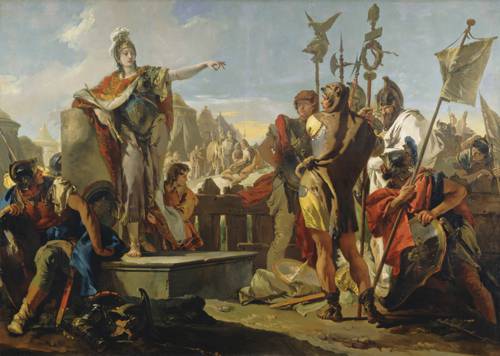
FAQ About Queen Zenobia

Who was Queen Zenobia?
Queen Zenobia was a third-century queen of the Palmyrene Empire in Syria who is notable for leading a revolt against the Roman Empire. She became a powerful symbol of resistance and is remembered for her ambition to expand her empire and her admiration for the cultures she ruled over.

What was the Palmyrene Empire?
The Palmyrene Empire was a splinter state that emerged from the Roman Empire during the 3rd century AD. It was centered around the city of Palmyra in present-day Syria and reached the peak of its power under the rule of Queen Zenobia, who expanded its territories across parts of the Eastern Roman provinces.

How did Queen Zenobia come to power?
Queen Zenobia came to power after the death of her husband, King Odaenathus, who was assassinated around 267 AD. Zenobia served as regent for her young son, Vaballathus, and quickly asserted her authority over the kingdom, taking on the title of queen.

Why did Queen Zenobia rebel against Rome?
Queen Zenobia rebelled against Rome primarily to consolidate and expand her power. Under her leadership, she sought autonomy for the Palmyrene Empire, which she felt was in her people's interests given the chaos in the Roman Empire at the time, particularly during the Crisis of the Third Century.

What were Queen Zenobia's major achievements?
Queen Zenobia's major achievements include expanding the Palmyrene Empire's territory to encompass Egypt and large parts of Asia Minor and Arabia. She also fostered cultural growth, promoting a diverse, intellectual climate in her realm by encouraging philosophical and scholarly activities.

How did the Roman Empire respond to Zenobia's rebellion?
The Roman Empire, under Emperor Aurelian, responded vigorously to Zenobia's rebellion. Aurelian campaigned against Zenobia in a series of military encounters, ultimately recapturing the territories she had taken and besieging Palmyra in 272 AD, which led to Zenobia's capture.

What happened to Queen Zenobia after her defeat?
After her defeat, Queen Zenobia was captured by Emperor Aurelian. There are differing accounts of her fate; some historical sources suggest she was paraded in Aurelian's triumph in Rome and later granted a villa in Tibur (modern Tivoli, Italy) where she lived out her days. Other sources imply a harsher fate, but the former is generally more accepted.

What is Queen Zenobia's legacy?
Queen Zenobia's legacy is one of a powerful and independent female ruler who challenged the might of Rome. She is celebrated for her leadership, cultural patronage, and ambition. Her story has inspired numerous works of art and literature, making her an enduring symbol of female empowerment and resistance against oppression.

How did Queen Zenobia influence culture during her reign?
Queen Zenobia influenced culture during her reign by promoting a fusion of Greek, Roman, and Eastern traditions. She encouraged scholarly pursuits and was known for her patronage of philosophers and intellectuals, contributing to a vibrant cultural environment in Palmyra.

What was Queen Zenobia's relationship with her son, Vaballathus?
Queen Zenobia acted as regent for her son, Vaballathus, following her husband's assassination. While he was formally recognized as her co-ruler, Zenobia held the de facto power during her rebellion against Rome, suggesting a dynamic where she managed the political and military affairs of the empire.

Did Queen Zenobia have a significant military background?
Queen Zenobia is not recorded as having a formal military background, but she demonstrated strong strategic and leadership qualities during her campaigns. Her ability to expand and manage a large portion of the Roman Eastern territories shows her keen sense of military tactics and political acumen.

How did Queen Zenobia's reign come to an end?
Queen Zenobia's reign came to an end after her defeat by Emperor Aurelian's forces in 272 AD. Her capture marked the collapse of the Palmyrene Empire, as the Romans reasserted control, and Palmyra was eventually reintegrated into the Roman Empire.

What are some misconceptions about Queen Zenobia?
One common misconception about Queen Zenobia is that she aligned herself with anti-Roman ideologies. In fact, her rebellion was not entirely anti-Roman but rather aimed at establishing greater autonomy and control for her rule. Another misconception is that she was solely a warrior queen, while she was also a patron of culture and the arts.

In what ways is Queen Zenobia depicted in art and literature?
Queen Zenobia has been portrayed in numerous forms of art and literature as a heroic and tragic figure. Paintings, sculptures, operas, and novels have depicted her as a romantic symbol of strength and defiance. Her legacy continues to inspire works that explore themes of power, rebellion, and female leadership.

What were the cultural influences in Zenobia's court?
Zenobia's court was a melting pot of cultural influences, predominantly Greek, Roman, and Eastern traditions. This cosmopolitan atmosphere reflected in the art, architecture, and intellectual life of Palmyra, as she encouraged the integration and appreciation of diverse cultural practices and ideas.

How did Zenobia's rebellion affect the Roman Empire?
Zenobia's rebellion presented a significant challenge to the Roman Empire during a period of internal instability. It prompted a robust response from Emperor Aurelian, which ultimately led to reforms that strengthened the Roman military and administrative systems. The rebellion also underscored the importance of maintaining quick and effective responses to provincial unrest.

What role did religion play in Zenobia's empire?
Religion played a notable role in Zenobia's empire, characterized by a blend of local traditions and more widespread Hellenistic and Roman practices. Zenobia herself was associated with various local deities and sought to accommodate different religious beliefs within her empire, promoting a degree of religious tolerance and integration.

What is known about Queen Zenobia's early life?
Details about Queen Zenobia's early life are sparse and often mixed with legends. She is believed to have been well-educated, with accounts suggesting that she was fluent in several languages, including Aramaic, Greek, and Egyptian, which would have served her well in her later political endeavors.

How did Zenobia's rule impact women's roles in her society?
Queen Zenobia's rule highlighted the potential for women to hold significant power and influence, challenging gender norms of the time. Her status and capability as a leader served as an inspiration, providing a powerful example that contributed to discussions about women's roles and capacities in society.

What archaeological evidence exists of Zenobia's reign?
Archaeological evidence of Zenobia's reign is primarily found in the city of Palmyra. Numerous inscriptions, sculptures, and architectural remnants depict the opulence and cultural sophistication of her court. Artifacts from this period testify to the extensive trade networks and cultural exchanges enabled under her rule.
